
A brochure from very early in the Twentieth Century. Note that the phone number was hand stamped to the left of the address, indicating that the Olivers had only recently acquired a telephone.
Page 1
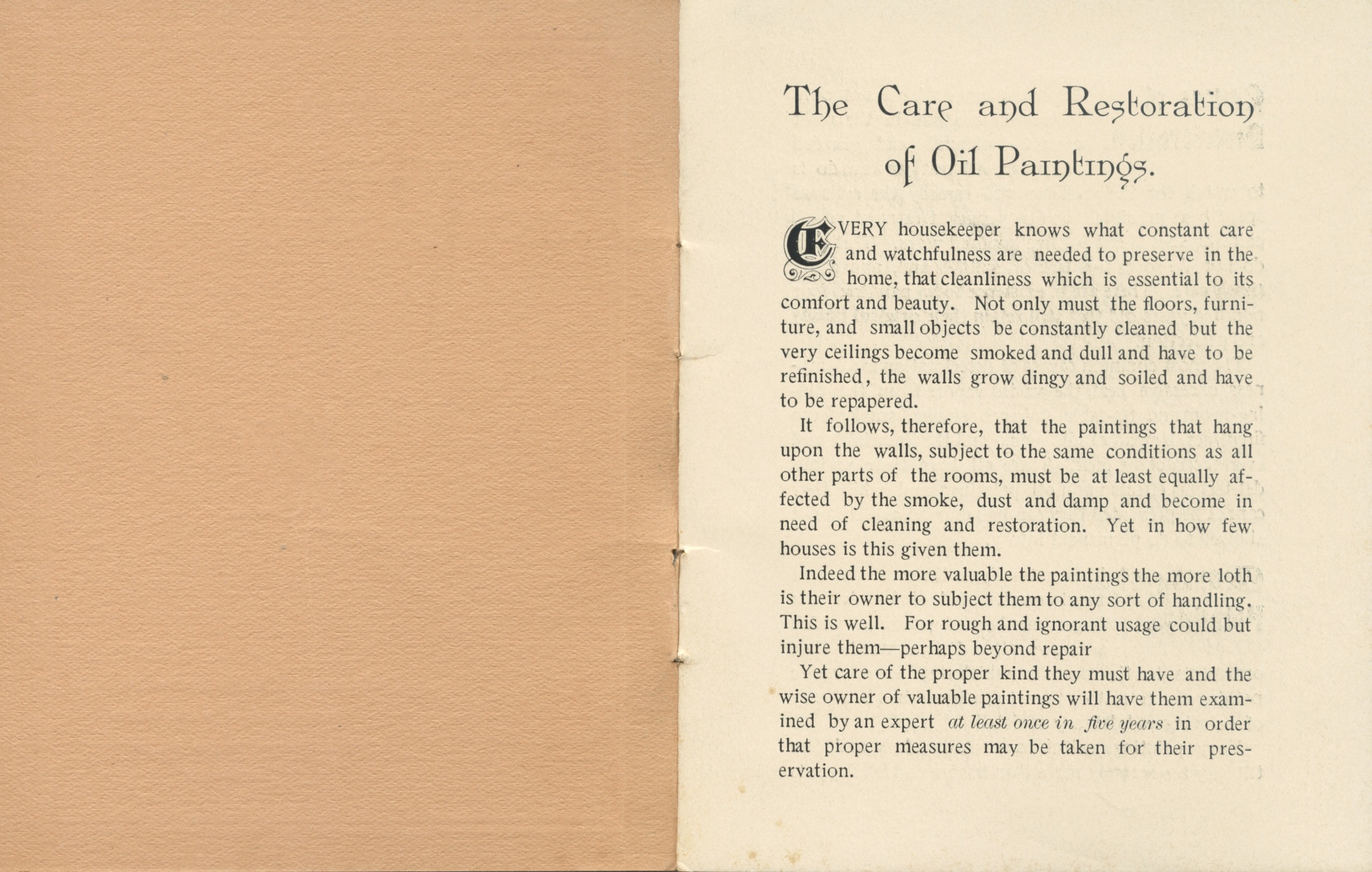
By Nineteen Ten, when they moved into the newly completed Fenway Studios Building, James Oliver’s Sons had hanged their name to OLIVER BROTHERS.
THE CARE AND RESTORATION OF OIL PAINTINGS.
EVERY housekeeper knows what constant care and watchfulness are needed to preserve in the home, that cleanliness which is essential to its comfort and beauty. Not only must the floors, furniture, and small objects be constantly cleaned but the very ceilings become smoked and dull and have to be refinished, the walls grow dingy and soiled and have to be repapered.
It follows, therefore, that the paintings that hang upon the walls, subject to the same conditions as all other parts of the rooms, must be at least equally affected by the smoke, dust and damp and become in need of cleaning and restoration. Yet in how fewhouses is this given them.
Indeed the more valuable the paintings the more loth is their owner to subject them to any sort of handling. This is well. For rough and ignorant usage could but injure them–perhaps beyond repair. Yet care of the proper kind they must have and the wise owner of valuable paintings will have them examined by an expert at least once in five years in order that proper measures may be taken for their preservation.
Pages 2 and 3
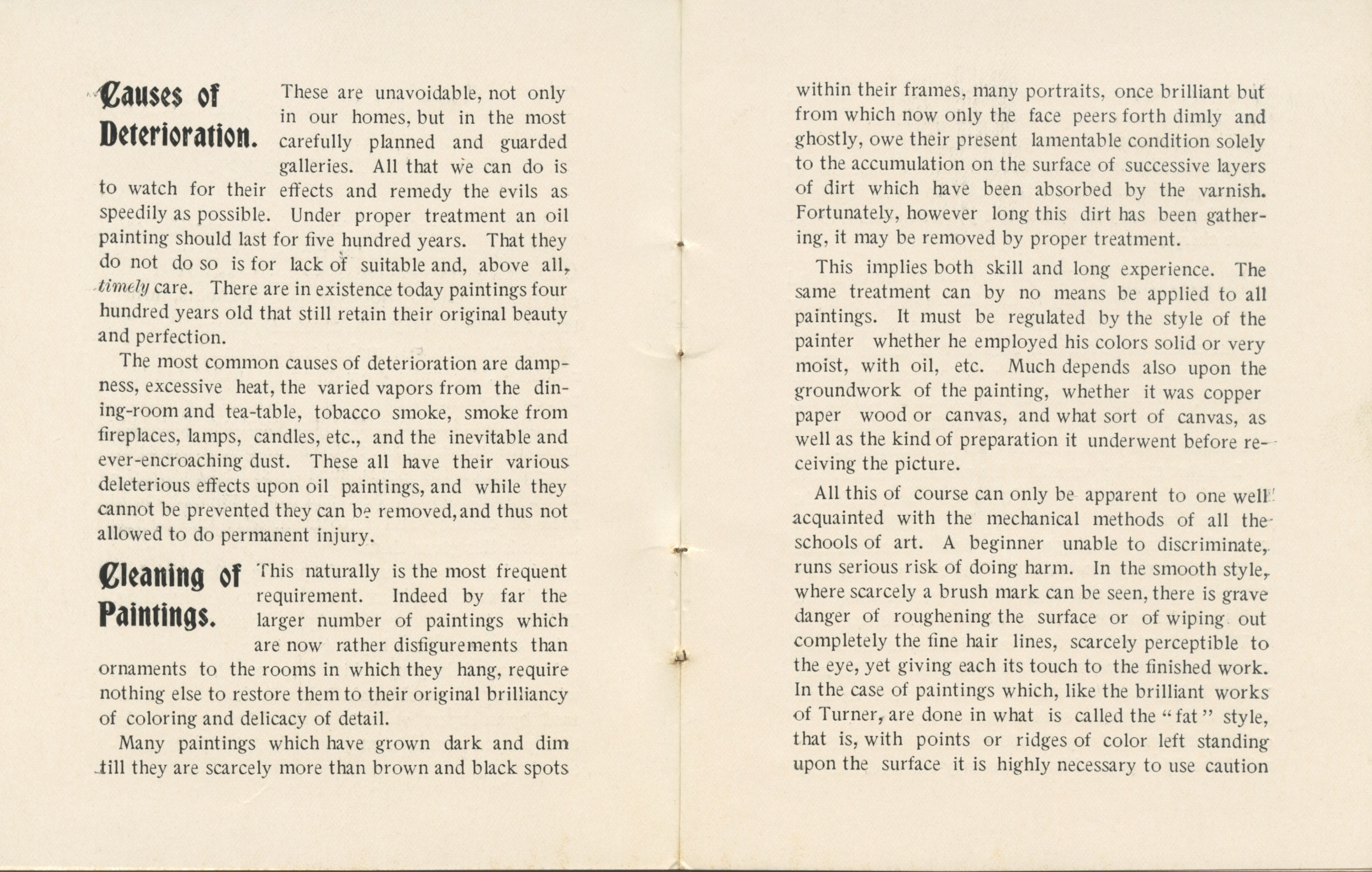
Before moving to Boston, the Oliver Brothers were held in high enough esteem in New York to have restored these important paintings for the Metropolitan Museum.
Causes of Deterioration
These are unavoidable, not only in our homes, but in the most carefully planned and guarded galleries. All that we can do is to watch for their effects and remedy the evils as speedily as possible. Under proper treatment an oil painting should last for five hundred years. That they do not do so is for lack of suitable and, above all, timely care. There are in existence today paintings four hundred years old that still retain their original beauty and perfection.
The most common causes of deterioration are dampness, excessive heat, the varied vapors from the dining-room and tea-table, tobacco smoke, smoke from fireplaces, lamps, candles, etc., and the inevitable and ever-encroaching dust. These all have their various deleterious effects upon oil paintings, and while they cannot be prevented they can be removed, and thus not allowed to do permanent injury.
Cleaning of paintings
This naturally is the most frequent requirement. Indeed by far the larger number of paintings which are now rather disfigurements than ornaments to the rooms in which they hang, require nothing else to restore them to their original brilliancy of coloring and delicacy of detail.
Many paintings which have grown dark and dim till they are scarcely more than brown and black spots within their frames, many portraits, once brilliant but from which now only the face peers forth dimly and ghostly, owe their present lamentable condition solely to the accumulation on the surface of successive layers of dirt which have been absorbed by the varnish. Fortunately, however long this dirt has been gathering, it may be removed by proper treatment.
This implies both skill and long experience. The same treatment can by no means be applied to all paintings. It must be regulated by the style of the painter : whether he employed his colors solid or very moist, with oil, etc. Much depends also upon the groundwork of the painting, whether it was copper, paper, wood or canvas, and what sort of canvas, as well as the kind of preparation it underwent before receiving the picture.
All this of course can only be apparent to one well acquainted with the mechanical methods of all the schools of art. A beginner, unable to discriminate, runs serious risk of doing harm. In the smooth style, where scarcely a brush mark can be seen, there is grave danger of roughening the surface or of wiping out completely the fine hair lines, scarcely perceptible to the eye, yet giving each its touch to the finished work. In the case of paintings which, like the brilliant works of Turner, are done in what is called the “fat” style, that is, with points or ridges of color left standing upon the surface it is highly necessary to use caution les the sharpness of these ridges be dulled and the painting lose much of its force and character.
The experience of two generations has toughed us the care and discrimination needed for the handling of all oil paintings. We are thus able to do the work of cleaning not only easily but safely, quickly—and therefore cheaply.
Pages 4 and 5
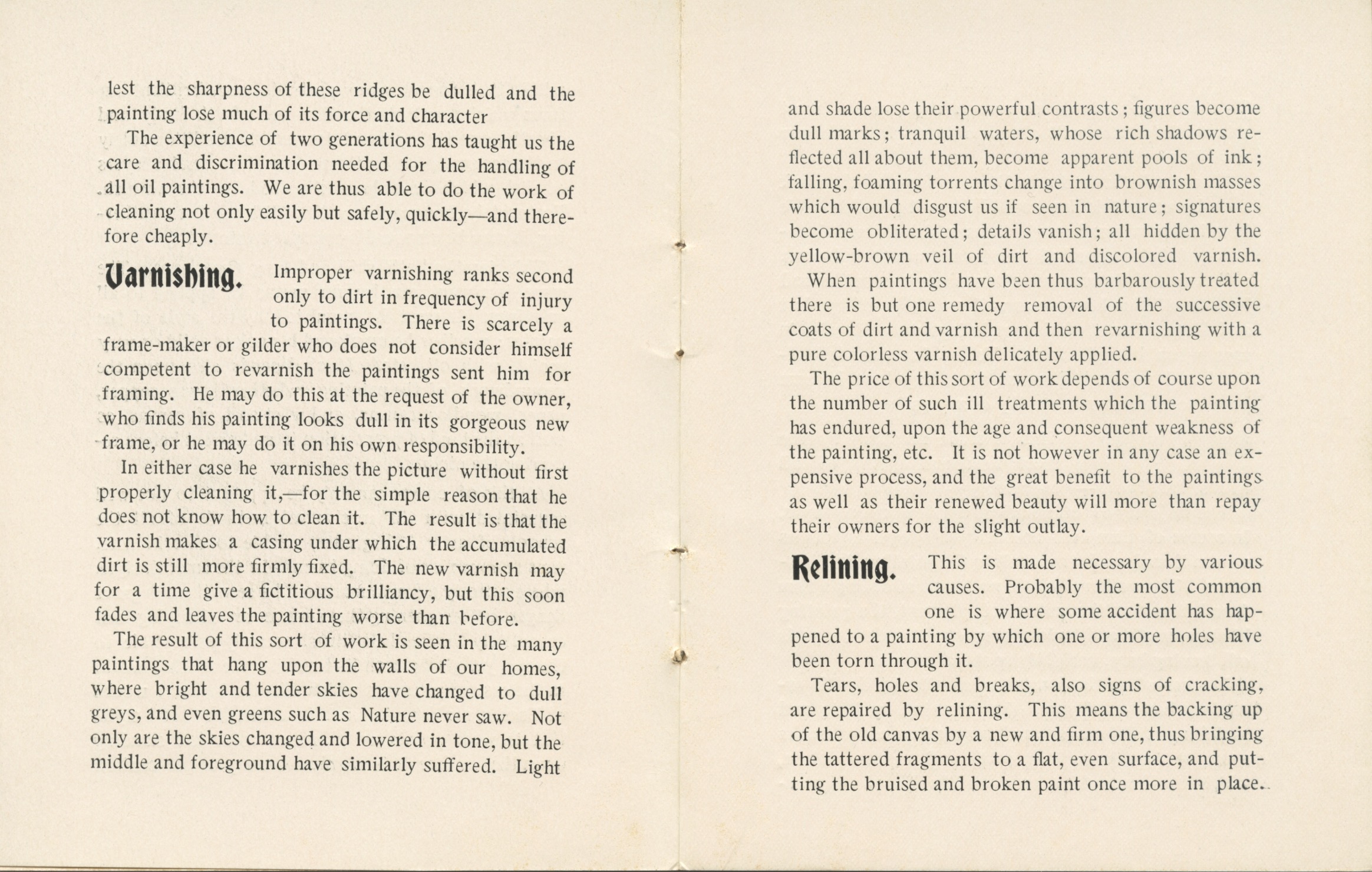
Varnishing
Improper varnishing ranks second only to dirt in frequency of injury to paintings. There is scarcely a frame-maker or gilder who does not consider himself competent to revarnish the paintings sent him for framing. He may do this at the request of the owner, who finds his painting looks dull in its gorgeous new frame, or he may do it on his own responsibility.
In either case he varnishes the picture without first properly cleaning it,–for the simple reason that he does not know how to clean it. There result is that the varnish makes a casing under which the accumulated dirt is still more firmly fixed. The new varnish may for a time give a fictitious brilliancy, but this soon fades and leaves the painting worse than before
The result of this sort of work is seen in the many paintings that hang upon the walls of our homes, where bright and tender skies have changed to dull greys, and even greens such as Nature never saw. Not only are the skies changed and lowered in tone, but the middle and foreground have similarly suffered.
Light and shade lose their powerful contrasts ; figures become dull marks ; tranquil water, whose rich shadows reflected all about them, become apparent tools of ink ; falling, foaming torrents change into brownish masses which would disgust us if seen in nature ; signatures become obliterated ; details vanish ; all hidden by the yellow-brown veil of dirt and discolored varnish.
When paintings have been thus barbarously treated there is but one remedy : removal of the successive coats of dirt and varnish and then revarnishing with a pure colorless varnish delicately applied.
The price of this sort of work depends of course upon the number of such ill treatments which the painting has endured, upon the age and consequent weakness of the painting, etc. It is not however in any case an expensive process, and the great benefit to the paintings as well as their renewed beauty will more than repay their owners for the slight outlay.
Relining.
This is made necessary by various causes. Probably the most common one is where some accident has happened to a painting by which one or more holes have been torn through it.
Tears, holes and breaks, also signs of cracking, are repaired by relining. This means the backing up of the old canvas by a new and firm one, thus bringing the tattered fragments to a flat, even surface, and putting the bruised and broken paint once more in place. This we are able to do so successfully that the most minute inspection will show no trace of the former condition.
No one who has not actually seen some of the work done by us on this line could believe it possible. We have had paintings brought to us which through ignorance of their value had been torn from their frames, rolled up and thrown into attics, there to molder and become still further torn as well as disfigured by dust and damp. Some of these paintings were literally in rags when brought to us. Yet we have mended, relined, and restored them so that they have become once more ornaments worthy of any gallery.
Pages 6 and 7
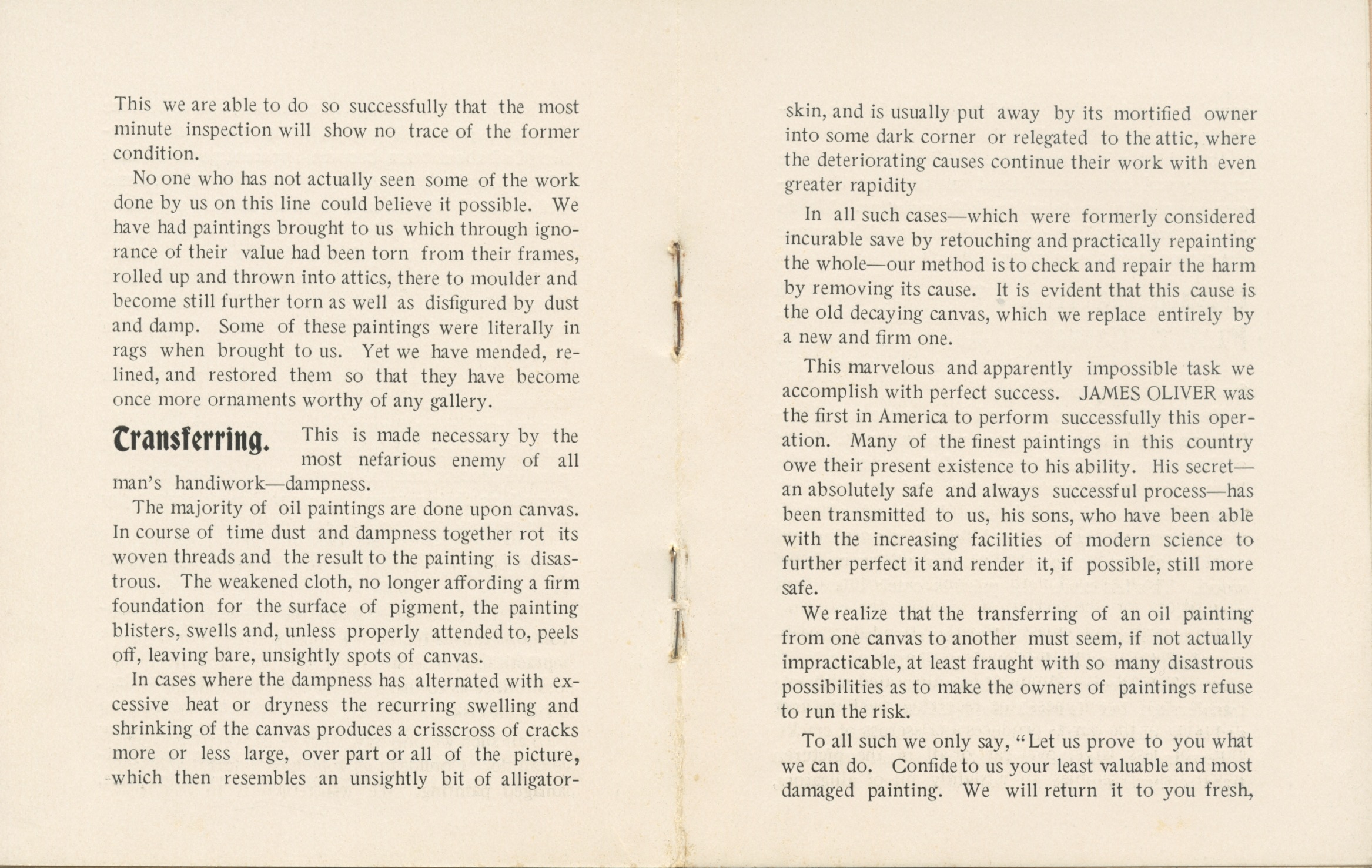
Transferring.
This is made necessary by the man’s handiwork—dampness.
The majority of oil paintings are done upon canvas. In course of time dust and dampness together rot its woven threads and the result to the painting is disastrous. The weakened cloth, no longer affording a firm foundation for the surface of pigment, the painting blisters, swells and, unless properly attended to, peels off, leaving bare, unsightly spots of canvas.
In cases where the dampness has alternated with excessive heat or dryness the recurring swelling and shrinking of the canvas produces a crisscross of cracks more or less large, over part or all of the picture, which then resembles an unsightly bit of alligator-skin, and is usually put away by its mortified owner into some dark corner or relegated to the attic, where the deteriorating causes continue their work with even greater rapidity.
In all such cases—which were formerly considered incurable save by retouching and practically repainting the whole—our method is to check and repair the harm by removing its cause. It is evident that this cause is the old decaying canvas, which we replace entirely by a new and firm one.
This marvelous and apparently impossible task we accomplish with perfect success. JAMES OLIVER was the first in America to perform successfully this operation. Many of the finest paintings in this country owe their present existence to his ability. His secret—an absolutely safe and always successful process—has been transmitted to us, his sons, who have been able with the increasing facilities of modern science to further perfect it and render it, if possible, still more safe.
We realize that the transferring of an oil painting from one canvas to another must seem, if not actually impracticable, at least fraught with so many disastrous possibilities as to make the owners of paintings refuse to run the risk.
To all such we only say, “Let us prove to you what we can do. Confide to us your least valuable and most damaged painting. We will return it to you fresh, sound, without crack or blemish and good for a hundred years more of life.”
As a hint of which may serve to dispel some of the mystery and consequent read surrounding the process, we say that we do not touch the painting. We do not remove the painting from the canvas. We remove the canvas from the painting.
Pages 8 and 9
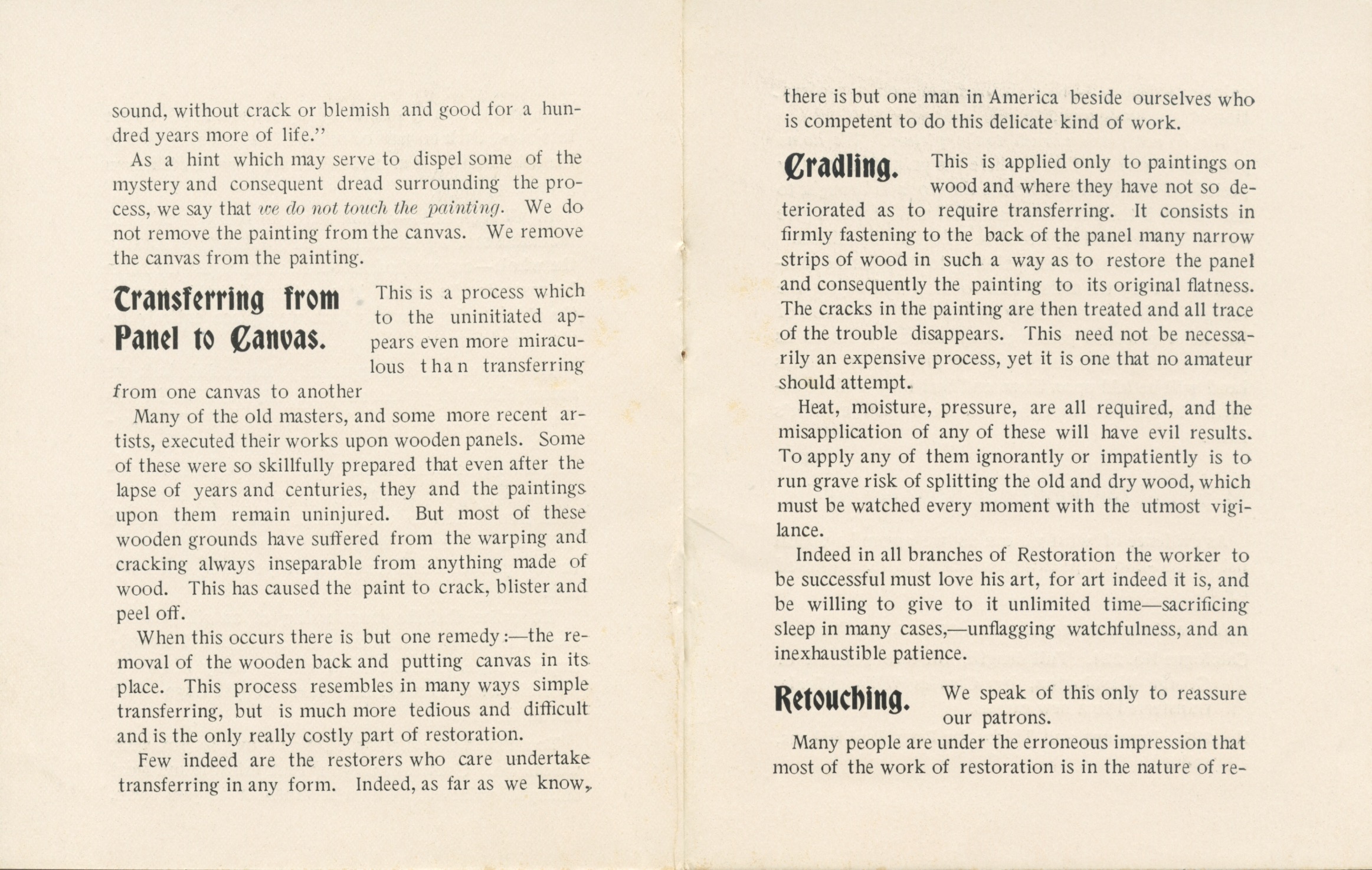
Transferring from Panel to Canvas.
This is a process which to the uninitiated appears even more miraculous than transferring from one canvas to another.
Many of the old masters, and some more recent artists, executed their works upon wooden panels. Some of these were so skillfully prepared that even after the lapse of years and centuries, they and the paintings upon them remain uninjured. But most of these wooden grounds have suffered from the warping and cracking always inseparable from anything made of wood. This has caused the paint to crack, blister and peel off.
When this occurs there is but one remedy:–the removal of the wooden back and putting canvas in its place. This process resembles in many way simple transferring, but is much more tedious and difficult and is the only really costly part of restoration.
Few indeed are the restorers who care undertake transferring in any form. Indeed, as far as we know, there is but one man in America beside ourselves who is competent to do this delicate kind of work.
Cradling.
This is applied only to paintings on wood and where they have not so deteriorated as to require transferring. It consists in firmly fastening to the back of the panel many narrow strips of wood in such a way as to restore the panel and consequently the painting to its original flatness. The cracks in the painting are then treated and all trace of the trouble disappears. This need not be necessarily an expensive process, yet it is one that no amateur should attempt.
Heat, moisture, pressure, all are required, and the misapplication of any of these will have evil results. To apply any of them ignorantly or impatiently is to run grave risk of splitting the old and dry wood, which must be watched every moment with the utmost vigilance.
Indeed in all branches of Restoration the worker to be successful must love his art, for art indeed it is, and be willing to give to it unlimited time—sacrificing sleep in many cases,–unflagging watchfulness, and an inexhaustible patience.
Retouching.
We speak of this only to reassure our patrons.
Many people are under the erroneous impression that most of the work of restoration is in the nature of repainting. Naturally they shrink from such a profanation of a valued work.
We do not touch a brush to the picture. We do no painting of any kind save where the paint has actually peeled off and been lost before the work is brought to us. Even if the paint has flaked off and you can give us the flake we will replace it in its original position.
Our aim is to restore a painting to its primal condition as left by the artist, and to stop and repair the ravages made by time, decay and accident. Owners of the most priceless paintings may entrust them to us with no misgivings, sure that no profane or careless hand will be laid upon them and that they will be returned to them as though fresh from their creator’s hand.
Pages 10 and 11
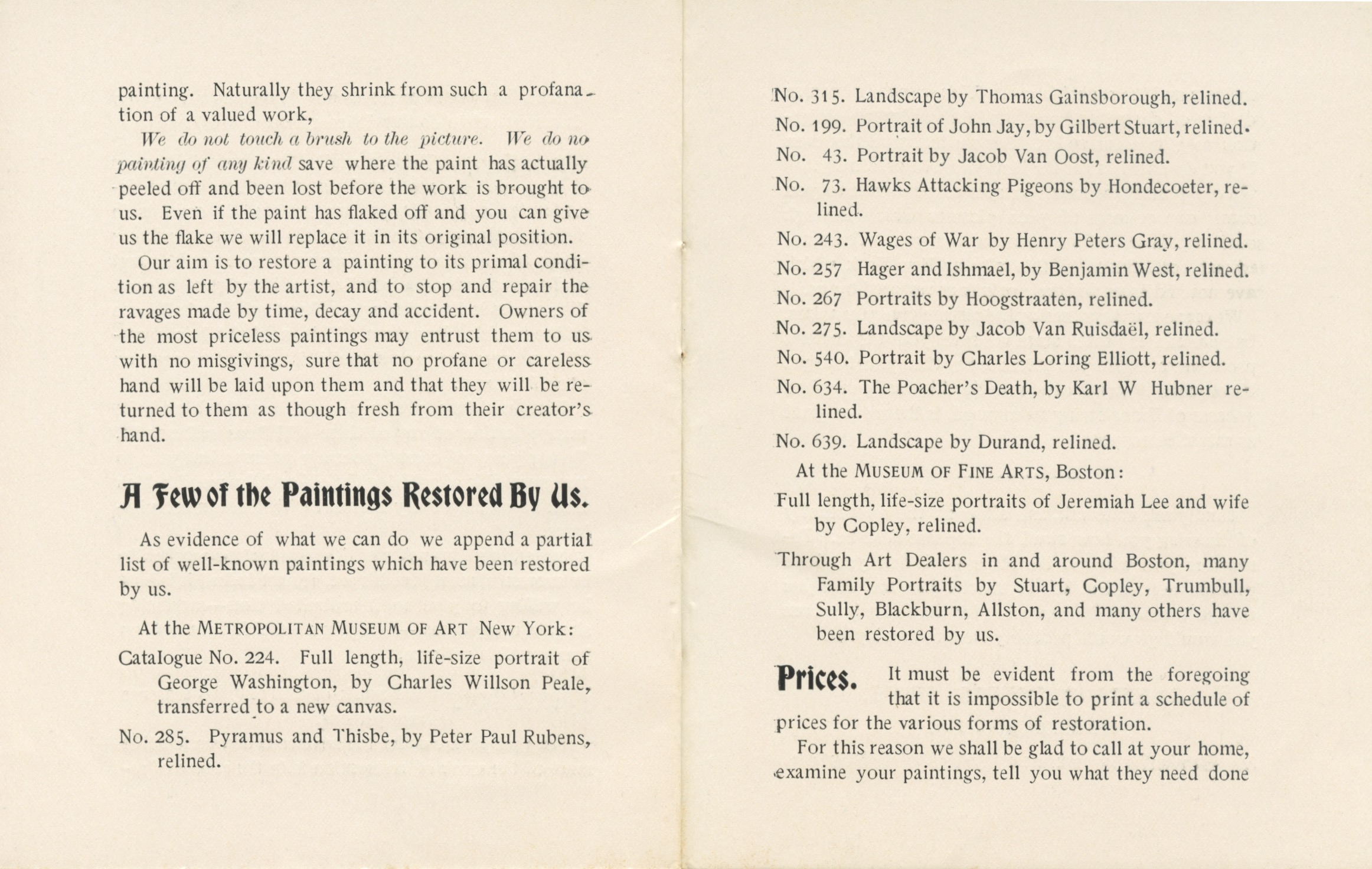
A Few of the Paintings Restored By Us.
As evidence of what we can do we append a partial list of well-known paintings which have been restored by us.
At the Metropolitan Museum of Art, New York:
Catalogue No. 224. Full length, life-size portrait of George Washington, by Charles Willson Peale, transferred to a new canvas.
No. 285. Pyramus and Thisbe, by Peter Paul Rubens, relined.
No. 315. Landscape by Thomas Gainsborough, relined.
No. 199. Portrait of John Jay, by Gilbert Stuart, relined.
No. 43. Portrait by Jacob Van Oost, relined.
No. 73. Hawks Attacking Pigeons by Hondecoeter, relined.
No. 243. Wages of War, by Henry Peters Gray, relined.
No. 257. Hager and Ishmael, by Benjamin West, relined.
No. 267. Portraits by Hoogstraaten, relined.
No. 275. Landscape by Jacob Van Ruisdaël, relined.
No. 540. Portrait by Charles Loring Elliot, relined.
No 634. The Poacher’s Death, by Karl W. Hubner, relined.
No. 639. Landscape by Durand, relined.
At the Museum of Fine Arts, Boston:
Full length, life-size portraits of Jeremiah Lee and wife by Copley, relined.
Through Art Dealers in and around Boston, many Family Portraits by Stuart, Copley, Trumbull, Sully, Blackburn, Allston, and many others have been restored by us.
Page 12
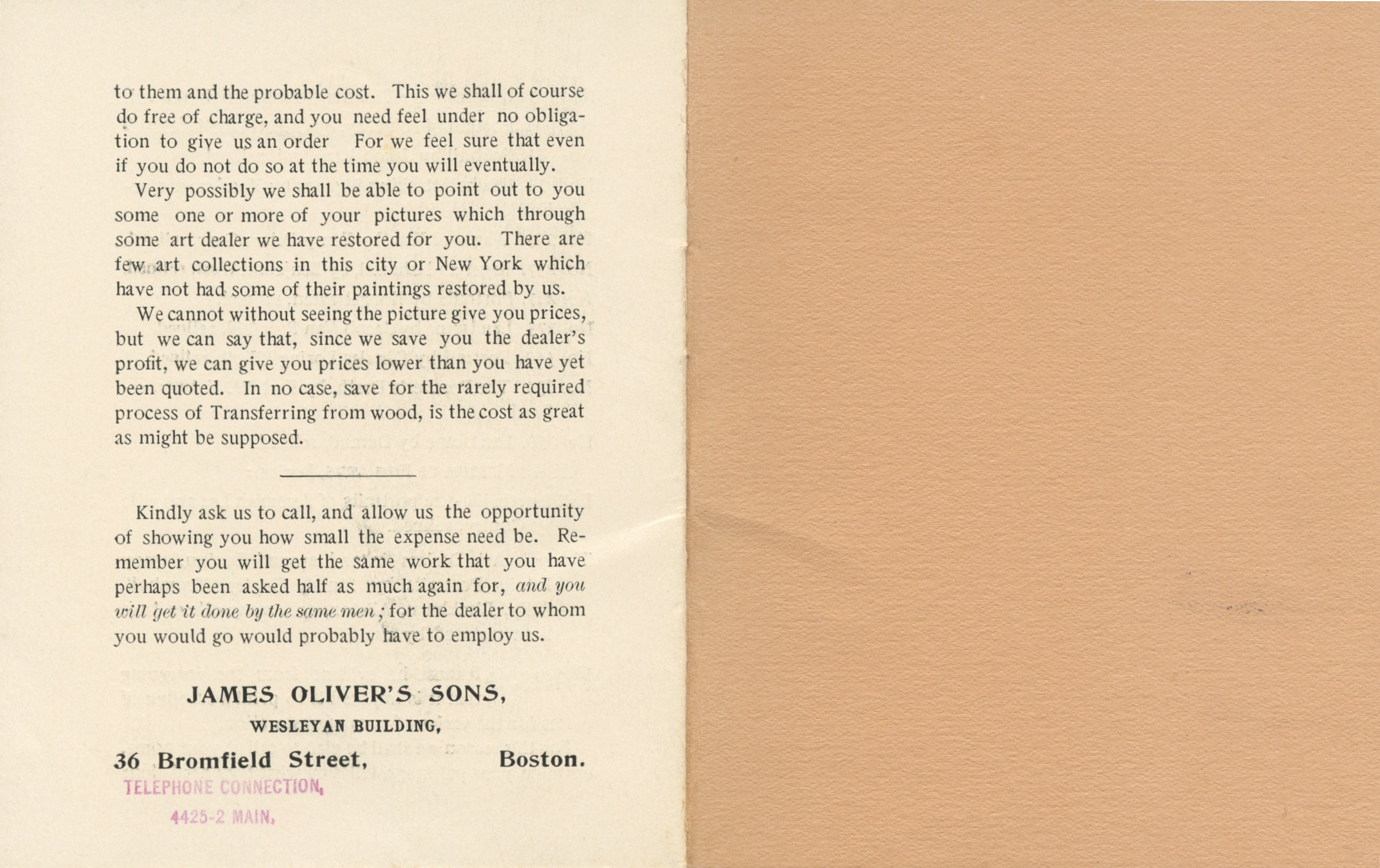
Prices.
It must be evident from the foregoing that it is impossible to print a scheduled of prices for the various forms of restoration.
For this reason we shall be glad to call at your home, examine your paintings, tell you what they need done to them and the probable cost. This we shall of course do free of charge, and you need feel under no obligation to give us an order. For we feel sure that even if you do not do so at the time you will eventually.
Very possibly we shall be able to point out to you some one or more of your pictures which through some art dealer we have restored for you. There are few art collections in this city or New York which have not had some of their paintings restored by us.
We cannot without seeing the picture give you prices, but we can say that, since we save you the dealer’s profit, we can give you prices lower than you have yet been quoted. In no case, save for the rarely required process of Transferring from wood, is the cost as great as might be supposed.
Kindly ask us to call, and allow us the opportunity of showing you how small the expense need be. Remember you will get the same work that you have perhaps been asked half as much again for, and you will get it done by the same men ; for the dealer to whom you would go would probably have to employ us.
JAMES OLIVER’S SONS, WESLAYAN BUILDING,
36 Bromfield Street, Boston
Telephone Connection, 4425-2 Main
Contact Oliver Brothers or call us to schedule an appointment at 617-536-2323
"*" indicates required fields